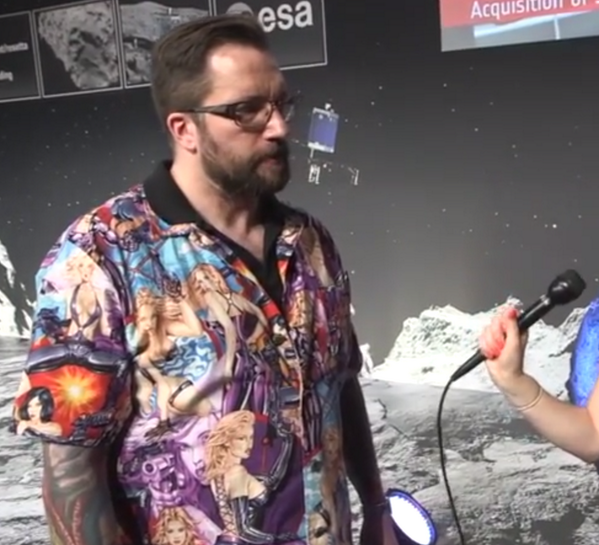

The European Space Agency landed a probe on a comet this week.
Unfortunately, there were a couple of malfunctions. In the first, the “harpoon” that was to anchor the lander malfunctioned allowing it to bounce around a bit.
These revealed the astonishing conclusion that the lander did not just touch down on Comet 67P/Churyumov–Gerasimenko once, but three times.
The harpoons did not fire and Philae appeared to be rotating after the first touchdown, which indicated that it had lifted from the surface again.
Stephan Ulamec, Philae manager at the DLR German Aerospace Center, reported that it touched the surface at 15:34, 17:25 and 17:32 GMT (comet time – it takes over 28 minutes for the signal to reach Earth, via Rosetta). The information was provided by several of the scientific instruments, including the ROMAP magnetic field analyser, the MUPUS thermal mapper, and the sensors in the landing gear that were pushed in on the first impact.
The result of this mishap was that the lander, which was using solar energy to recharge batteries, was not positioned properly to absorb the very weak sunlight energy at that distance.
But then the lander lifted from the surface again – for 1 hour 50 minutes. During that time, it travelled about 1 km at a speed of 38 cm/s. It then made a smaller second hop, travelling at about 3 cm/s, and landing in its final resting place seven minutes later.
That is quite a move and the result has been a very limited experiment as the lander has now shut down due to low battery power.
The landing, as sensational as it has been, has been completely overshadowed by a controversy over the shirt worn by the project director at the press conference.

The shirt seems to have images of scantily clad women on it and the world’s feminists erupted in wrath.
“No no women are toooootally welcome in our community, just ask the dude in this shirt,” tweeted The Atlantic tech writer Rose Eveleth.
The poor dear ! The incident reminds of the hilarious (to me) incident with Larry Summers, when he was the President of Harvard. He made the mistake, when meeting with faculty, of musing that, perhaps, women were less interested in science than men. The result was a huge controversy that resulted in his resignation. The funniest (again to me) response to his comments was this:
The most remarkable feminist exercise in self-parody was that of MIT biology professor Nancy Hopkins, who famously told reporters that she “felt I was going to be sick,” that “my heart was pounding and my breath was shallow,” that “I just couldn’t breathe, because this kind of bias makes me physically ill,” and that she had to flee the room because otherwise “I would’ve either blacked out or thrown up.” The poor dear ! I wonder if she can stand the sight of blood ?
Even law professors of otherwise libertarian leanings are outraged !
And I will be more provocative: In the broad span of human culture, fashion is more important than space travel.
Back to Glenn:
… Then some women noticed that one of the space scientists, Matt Taylor, was wearing a shirt… featuring comic-book depictions of semi-naked women.
Some women noticed? Everyone noticed! It was an extremely showy shirt, and Taylor chose it for some reason. We were supposed to pretend we didn’t see it? It’s not as though the “some women” made something out of nothing. To blame the women for making this a topic is to impose a burden on us all to shut up about something obvious. If Taylor had wanted to keep everything focused on the achievements of the team he was on, he wouldn’t have picked that shirt. Why attack the women?
Why indeed ? They are only reacting inn the way their hormones dictate. After all, colleges are now having to include “Trigger Warnings” in course materials and even descriptions of classes, lest sensitive female and transgender students be wounded.
To add to the amusement, there is actually research (performed prior to the present atmosphere of intimidation) on sex differences in mathematical ability in children.
In the November 2000 issue of Psychological Science, for example, a team headed by Vanderbilt University’s Camilla Persson Benbow summarized earlier research showing “sex differences in mathematical precocity before kindergarten”; “sex differences in mathematical reasoning as early as the second grade (among intellectually gifted students)”; and “pronounced sex differences in mathematical reasoning ability” in a 1980 study of 9,927 intellectually talented 12-to-14-year-olds.
That would never be allowed these days.
The shirt, by the way, is sold out. He gets to keep his tattoos, I guess, and that should suggest his sartorial taste.
The other issue, ignored by almost all the female commenters on the event, is the choice of energy source for the lander.
The comet is, after all, powered by solar panels that need six or seven hours of sunlight per day to recharge the batteries.
its solar cells are only receiving an hour and a half of sunlight each day instead of the six or seven hours needed to recharge its batteries for extended operation. If nothing is done to improve its orientation, Philae likely will exhaust its battery and shut down sometime during the next few days.
It has already shut down.
The next issue is whether there is enough sunlight energy at that distance, 317 million miles from earth. The other alternative would be nuclear power, which has been used on other probes.
For more than 50 years, NASA’s robotic deep space probes have carried nuclear batteries provided by the U.S. Department of Energy. Even the crewed Apollo moon landings carried nuclear powered equipment.
However, the United States’ supply of plutonium-238, which fuels these batteries, called radioisotope thermoelectric generators (RTGs), is running low. Experts worry that ambitious planetary science missions in the future may have to be put on hold until more of the radioactive substance is available.
With the current state of the nuclear power industry, that may be a while.







